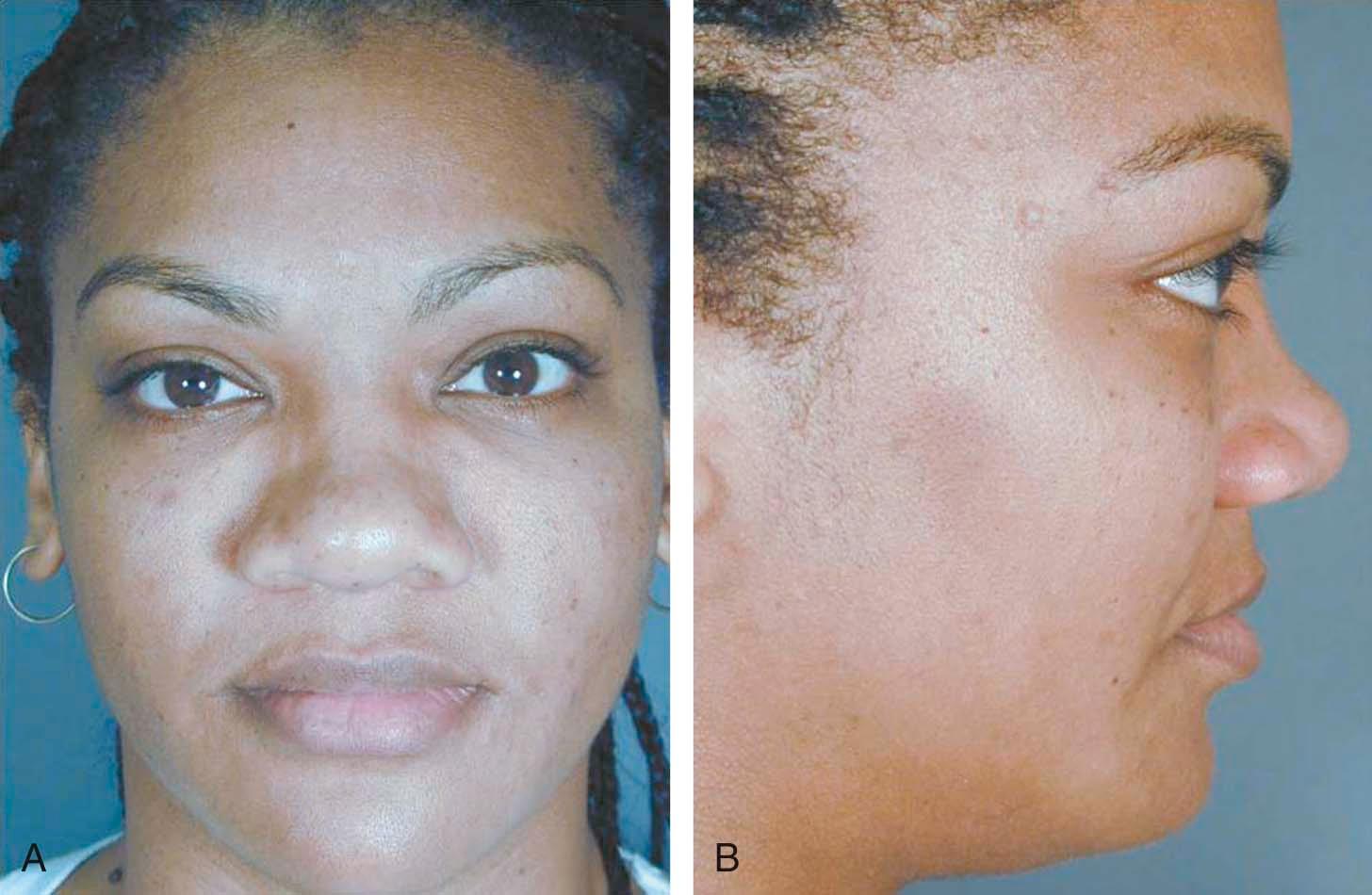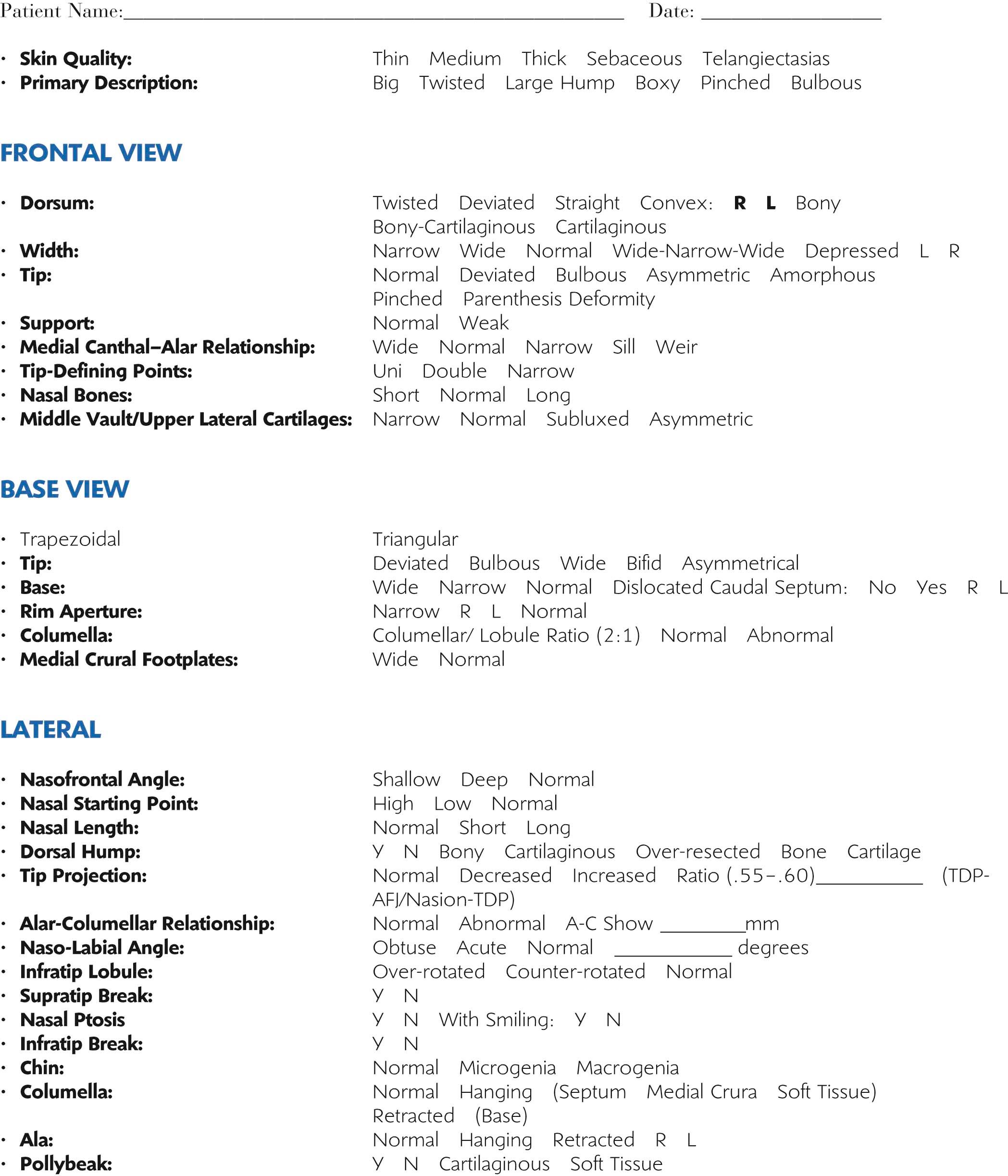Physical Address
304 North Cardinal St.
Dorchester Center, MA 02124
Rhinoplasty in the African American population presents a unique set of challenges, including skin and soft tissue envelope thickness, alar base width, and inherent ethnic considerations. A delicate balance of patient satisfaction, achieving an aesthetically pleasing result, and maintaining a natural appearance are three goals to stay focused on during the surgical planning and execution phases of these procedures. Among these, meeting the patient's expectations can sometimes require redirecting and demonstrating alternatives to patients with unrealistic expectations who may at first desire an overly narrow Caucasian nose. Some patients may even choose to bring celebrity photographs to the consultation, requesting a particular result, despite the absence of a match with the subject's face, skin type, body habitus, or ethnic background. Occasionally, one of the surgeon's most important tasks is to demonstrate to patients that their requested result is unrealistic, nonfunctional, aesthetically incongruous, or out of harmony with the patient's facial or other features and is at times in fact outright unachievable given their skin characteristics. Morphing software may serve as a visual aid in this demonstration. Only after this task is accomplished should the surgeon proceed with a careful review of the history and physical examination. A comprehensive understanding of nasal anatomy, function, and surgical techniques is paramount. Having an extensive preoperative discussion encompassing patient expectations, surgical goals, and a detailed list of potential complications with the patient preoperatively can prevent miscommunication. This is best accomplished by reviewing the exam, previous operative summary, photographs, nasal analysis sheet, problem list, and surgical plan preoperatively before proceeding with the surgical treatment.
African American rhinoplasty can be one of the most difficult and challenging of the multitude of ethnic rhinoplasty procedures primarily because of the imbalance between the weak nature of the cartilaginous framework and thick skin–soft tissue envelope. One of the most common pitfalls in African American rhinoplasty occurs while attempting to accomplish a less bulbous nasal tip. The experienced rhinoplasty surgeon will be in tune with this inherent anatomic imbalance and avoid aggressive lower lateral cartilage over-resection. Aggressive lower lateral cartilage reduction usually results in:
Loss of tip support
Decreased tip projection
Counterrotation (ptotis)
Decreased tip definition (and, in fact, more pronounced bulbosity)
Possible nasal tip contour irregularities
Proclivity for long-term collapse after primary rhinoplasty
For all rhinoplasty procedures, especially ethnic rhinoplasty, aggressive cartilage removal is a procedure of the past. Concepts such as limited cartilage excision and adding nasal support with structural grafting and tip suturing techniques are being taught in both training programs and meetings. Proceeding in this fashion may lead to a decrease in the need for a future secondary rhinoplasty.
This chapter will discuss some of the nuances of the anatomy of the African American nose, followed by goals, preoperative nasal evaluation with surgical planning, surgical sequence and techniques, postoperative nasal care, risks and complications, pearls, as well as preoperative and postoperative photography techniques.
A brief description of the African American nose is discussed and the descriptions described are present in the majority, but not all, of the typical African American noses ( Figure 30-1 ). These include the following characteristics:
The skin–soft tissue envelope is thick with abundant fibrofatty tissue.
The radix is deep, low, and inferiorly set.
The nasal bridge and dorsum feature short, wide, and flat nasal bones.
The nasal tip is bulbous, thick-skinned, poorly projected, and counterrotated (ptotic) with abundant fibrous nasal superficial musculoaponeurotic system plane (SMAS) and broad domes; it has minimal tip definition and weak lower lateral cartilages.
The columella is short and retracted with minimal columellar show.
The alae are wide, thick, and horizontal and the nostrils are flared.
Nasolabial junction: retracted, acute nasolabial angle (<90 degrees), underdeveloped nasal spine.
Maxilla: retruded and/or hypoplastic.

The usual primary goals in African American rhinoplasty can include the following:
Bridge: moderately thinner on frontal view.
Dorsum: augmented height on lateral view.
Tip: improve definition, increase projection, increase rotation.
Base: vertical-oblique nostrils and nasal base approximating an equilateral triangle.
Columella: Increased columellar “show” and length.
Nasolabial junction: obtuse nasolabial angle (>90 degrees).
Maxilla: less retruded.
Skin–soft tissue envelope: moderate thickness that allows good tip definition.
Excellent physician-patient communication is one of the most important features of the consultation process. While a detailed history is performed, listen very carefully to the patient's wishes and goals. Does he or she have realistic expectations? This is one of the most important details that the astute surgeon needs to focus on from the interview. What is the focus of the patient's dissatisfaction—a bulbous tip or a low dorsum? During the history, the surgeon should be able to identify if the patient is a good surgical candidate. Will your conservative rhinoplasty make the patient happy? Poor patient selection can lead to an unhappy patient and considerable amount of stress to both patient and surgeon.
Ascertain if the patient has nasal obstruction, although this symptom is uncommon. If nasal obstruction is present, is it static or dynamic? Is it present with normal or deep inspiration? What alleviates and worsens the nasal obstruction? What are the characteristics of the nasal obstruction? The physical examination follows.
For the physical examination, I use a nasal analysis worksheet ( Figure 30-2 ) and perform a detailed visual and tactile evaluation of the nose. Visualize the bilateral paramedian vertical light reflexes along the dorsum and look for symmetry. I then use an ungloved finger to palpate the nose, examining the bony and cartilaginous skeleton, tip, and skin–soft tissue envelope characteristics in frontal, head-down, oblique, lateral, and base views.

In patients with nasal obstruction, whether for a primary or revision rhinoplasty, I observe them during normal and deep inspiration on frontal and basal views. Often, the diagnosis is easily identifiable as supra-alar, alar, and/or rim collapse (slitlike nostrils) during static or dynamic states. External valve collapse (lower lateral cartilage pathology) can be evaluated by supporting the area of nasal obstruction with the firm end of a cotton swab while occluding the contralateral nostril. Often, nasal obstruction in the supra-alar region may signify an overly narrowed pyriform aperture secondary to low lateral osteotomies. Elevate the ptotic nasal tip and see if this helps alleviate the nasal obstruction. The Cottle maneuver can help assess internal valve collapse. Although this test is generally nonspecific, internal nasal valve pathology caused by supra-alar pinching or a narrowed angle between the upper lateral cartilage and septum can be diagnosed. On basal view, examine the medial crura feet and the recurvature of the lower lateral cartilage to identify if these impinge into the nasal airway.
Following a thorough external nasal evaluation, the endonasal examination ensues. At a minimum, perform anterior rhinoscopy. Evaluate the nasal septum for perforations, deviation, and septum characteristics, as the African American patient will usually have a short septum with insufficient cartilage for grafting. Other causes of nasal obstruction to identify are hypertrophic inferior turbinates, synechiae between the lateral nasal wall and septum, nasal masses, and middle turbinate abnormalities (concha bullosa, among others).
As the examination progresses, create a list of problems with solutions, followed by documentation on your nasal analysis sheet, such as (1) bulbous, poorly projected tip with a plan of open rhinoplasty, (2) low dorsum with a plan of augmentation with diced cartilage wrapped in deep temporalis fascia, and (3) wide ala with a plan of bilateral alar base reduction. If structural grafting is necessary, decide what material may be used. A thorough understanding of the types of autologous (septal, conchal, costal cartilage and deep temporalis fascia) or alloplastic grafting is needed as well as being facile with the harvesting techniques required for each one.
Computer imaging and morphing software may be an extremely useful method of communication if patients are made well aware that the final image will not represent their postoperative photograph. However, despite proper notification and consent, there have been reports of lawsuits filed by patients for outcomes that are different than what was generated by the surgeon. Computer imaging can give clues to the patient's expectations. Unrealistic expectations can be identified when a conservative image is generated by the surgeon and the patient desires a radical change. Therefore, computer imaging can be a powerful tool in evaluating patients for surgery. There have been numerous instances when I have decided not to perform rhinoplasty surgery secondary to the patients having unrealistic expectations only being identified by the computer morphing. An additional use for the computer image is to use it as a goal in surgery. Often in African American rhinoplasty, the patient has microgenia, and a chin implant would benefit the overall aesthetic appearance. Computer imaging will help the patient make a decision to have a chin implant. Prior to surgery, standardized rhinoplasty photographs are taken.
The sequence I find useful is to start with the septoplasty with septal harvesting and possible inferior turbinoplasty. This is followed by rhinoplasty incisions and skeletonization; I favor the external approach primarily—nasal tip surgery with harvesting/placement of autologous grafts, osteotomies as needed, dorsal augmentation with autologous and/or alloplastic grafts, and finally alar base reduction.
Become a Clinical Tree membership for Full access and enjoy Unlimited articles
If you are a member. Log in here